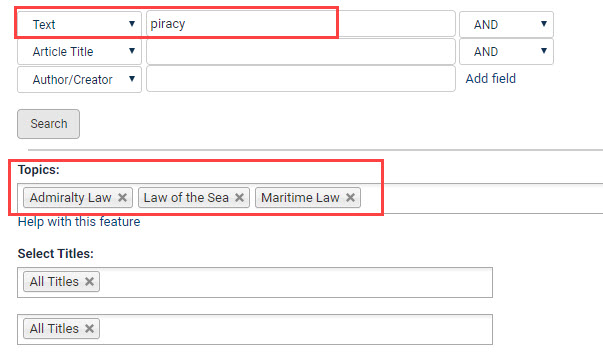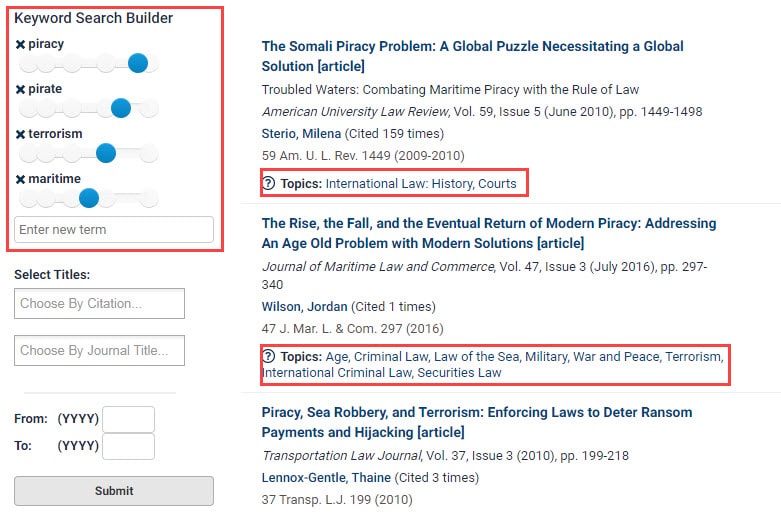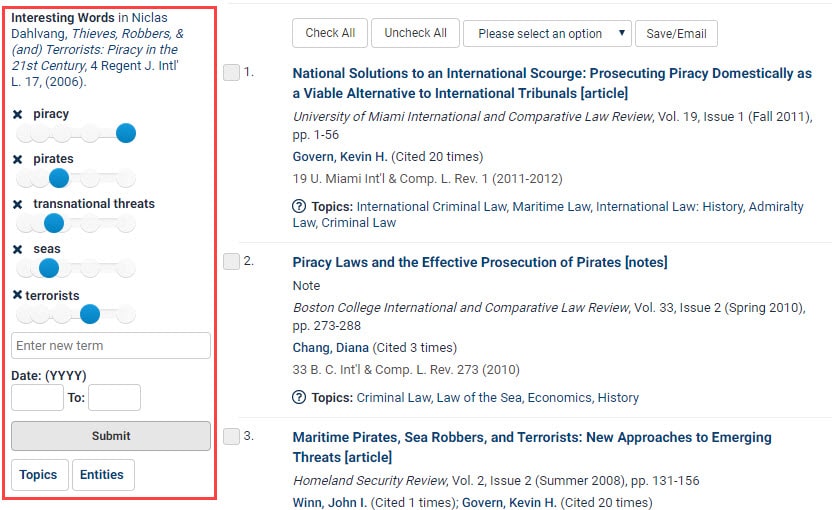Ahoy there, maties! This very day be International Talk Like a Pirate Day. Do ye know wha’ that means? Aye, that’s right, me hearties—we shall be natterin’ about pirates today! Ready yer sea legs, grab yer cup o’ grog, and leave them landlubbers behind.
Before We Get Started
Don’t miss out, ye filthy scallywags! Ye’ll need the databases below to follow along with this post. Click the links below to start yer trial today.
Piracy: Then and Now
Piracy, or the act of robbing ships at sea, has existed since the emergence of maritime trade. During the 2nd millennium B.C.E, developing civilizations on the coast of the Mediterranean Sea frequently weathered pirate raids or engaged in piracy themselves. The Illyrians, a group of Indo-European tribes, particularly became infamous during this time as fearsome pirates and skilled warriors. Known for their frequent raids of Greek and Roman trade vessels, the Illyrians soon became regarded as keepers of the Adriatic and Ionian Seas.
During the Dark and early Middle Ages, Vikings took over as the most notable sea raiders. With advanced sailing and navigational skills as well as innovative ship design, the Vikings became well known for raiding, pillaging, and trading as far south as North Africa. Though considered “pirates” at the time, the acts of the Vikings spread Scandinavian culture throughout Europe, forever changing the development of later nations.
The 17th century saw a surge in maritime exploration, the frequent establishment of overseas colonies, and an increase in the amount of valuable, shippable cargo. These factors combined laid the groundwork for a “golden age” of piracy that would last through the 1800s. Some of the most well-known pirates began their careers during this era, including William “Captain” Kidd, Bartholomew “Black Bart” Roberts, and Edward Teach, “Blackbeard.”
As nations across the globe padded their navies in response, the “golden age” of piracy slowly declined throughout the 19th century. Toward the end of the 20th century, piracy made a resurgence in hot spots such as the Gulf of Guinea, the Indian Ocean, and the Strait of Malacca. Though seemingly in decline as we approach the 2020s, pirate attacks still continue today. Unlike their Golden Age predecessors, modern-day pirates are no longer simply engaging in high-seas theft. Instead, piracy, terrorism, smuggling, and human trafficking have begun to go hand-in-hand. Learn more about global efforts to combat 21st-century piracy with HeinOnline.
Piracy and the Law of the Sea
The act of piracy falls under the “universality principle” of international law, allowing any government to “exercise jurisdiction over conduct outside its territory if that conduct is universally dangerous to states and their nationals.” Individual governments may therefore punish any pirate found within their jurisdiction, regardless of the location of the act. In the United States, for example, the criminal prosecution of piracy is codified in Title 18 of the U.S. Code, which states: “Whoever, on the high seas, commits the crime of piracy as defined by the law of nations, and is afterwards brought into or found in the United States, shall be imprisoned for life.”
Though maritime trade, travel, and piracy have existed since before the Common Era, the first attempt to create a comprehensive body of international law was not until the 1956 United Nations Conference on the Law of the Sea (UNCLOS I). The conference expanded the reach of coastal nations to a further distance from the shore—sometimes up to 200 nautical miles—and resulted in four treaties:
- The Convention on the Territorial Sea and Contiguous Zone
- The Convention on the Continental Shelf
- The Convention on the High Seas
- The Convention on Fishing and Conservation of the Living Resources of the High Seas
The official codification of international definitions and laws regarding piracy were laid out in the Convention on the High Seas.
Between 1973 and 1982, the third United Nations Conference on the Law of the Sea (UNCLOS III) convened to elaborate on the use of international waters by individual nations, businesses, and other entities. The resulting Convention on the Law of the Sea entered into force in 1994, replacing the previous four treaties and further defining boundaries and zones within the world’s oceans. The resulting defined zones still in existence today include:
- Internal waters, or the waters belonging to a specific coastal nation. Foreign vessels may not freely pass within internal waters.
- Territorial waters, or the waters extending 12 nautical miles from the baseline of a specific coastal nation. Foreign vessels have the right to innocent passage through territorial waters (e.g., passing through without disrupting the peace or security of the nation in question).
- Contiguous zone, or the waters beginning beyond the 12 nautical miles of the territorial waters. In the contiguous zone, a nation can continue to enforce only customs, taxation, immigration, and pollution laws.
- Exclusive economic zones, or waters extending 200 nautical miles from the baseline. The coastal nation in question is given sole rights over all natural resources in this area.
- Continental shelf, or the natural extension of a nation’s land territory from its baseline. A nation has the right to the resources within its continental shelf up to 350 nautical miles from the baseline.
- The high seas, or the open ocean that is not part of the territorial or internal waters of a country.
Similar to the previous Convention, UNCLOS III provided an international definition of piracy as well as the responsibilities of its party states in combating acts of piracy.
After catching up on important international documents relating to piracy and the law of the sea, utilize HeinOnline’s unique natural language processing, machine learning, and research tools to discover related legislation, journal articles, books, and more. HeinOnline’s Topic and Entity Extraction, Keyword Search Builder, More Like This, and Venn Diagram Search features are valuable tools for discovering relevant content throughout HeinOnline’s databases.
Topics and Entities
HeinOnline uses machine learning to extract topics and entities (relevant locations, persons, organizations, etc.) from individual articles. Utilize these extracted topics for easy searching in the Law Journal Library. Navigate to the Advanced Search option hyperlinked in blue under the main search bar. Enter any relevant keywords into the text boxes, and then search for relevant subjects within the “Topics” field. For the subject of piracy, users may craft their advanced search by modeling the below to yield nearly 1,800 related results.

Keyword Search Builder
From the same Advanced Search option in the Law Journal Library, the Keyword Search Builder is available to help users construct productive searches. After selecting the Keyword Search Builder button, users will be redirected to a series of keyword boxes, each with its own scale. Insert terms relevant to the topic and adjust the boost factors to allocate their respective weights. For example, insert terms relating to piracy to view a host of relevant results, including:
- The Somali Piracy Problem: A Global Puzzle Necessitating a Global Solution
- Piracy, Sea Robbery, and Terrorism: Enforcing Laws to Deter Ransom Payments and Hijacking
- Thieves, Robbers, & Terrorists: Piracy in the 21st Century
- Piracy: New Efforts in Addressing this Enduring Problem
Related topics extracted through machine learning also appear in the results.

More Like This
To use the More Like This tool, let’s choose one of the relevant articles listed above, Thieves, Robbers, & Terrorists: Piracy in the 21st Century.
From any page in the article, click on the More Like This button to the right above the document. Users will be redirected to “interesting words” in the article, as determined by an algorithm. View a list of similar articles based on the “interesting words” or adjust the terms and their respective weights to narrow the search.

Venn Diagram Search
Finally, use HeinOnline’s Venn Diagram Search to visualize the relationship between the terms and the number of results they yield in various combinations. The Venn Diagram Search can be found in the same Advanced Search option underneath the main search bar. After selecting the Venn Diagram Search button, users will be redirected to the search interface.
Enter two or more terms or phrases into the search bar, each separated by the Boolean operator “AND” (e.g., piracy AND terrorism AND “united nations”). Visualize the different combinations of the terms with the Venn Diagram that appears, and use the results to better refine your searches on the topic.

Avast, ye! Did ye like that there piece? Discover more fine content when ye click Subscribe on the starboard side o’ this here post. Don’t ye forget to connect with HeinOnline on our social media platforms, neither! Facebook, Twitter, Instagram, and YouTube.



